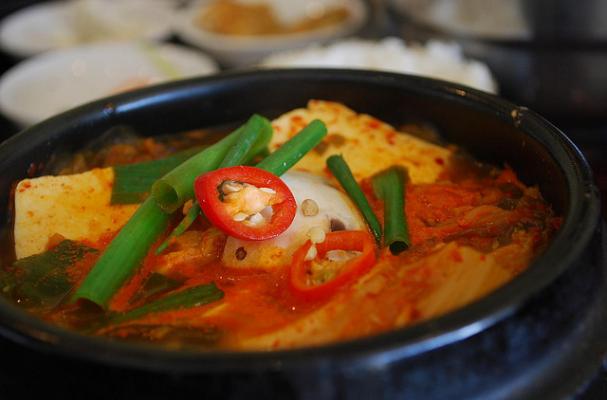
Kimchi stew (or kimchi jjigae) is perhaps the most common type of hot pot-style stews in Korea. A deliciously salty, hot pepper-laced broth is filled with kimchi (a spicy fermented pickled cabbage), cubes of velvety tofu, thin slices of pork or sometimes seafood, garlic and green onions. Jjigae are traditionally placed in the center of the table and served communally along with rice and an assortment of small side dishes known as banchan. These small dishes typically consist of various kimchi, gochujang (a hot pepper paste), soy sauce and other sauces and condiments, seaweed, bean sprouts, and radish - to name a few.
This kimchi jjigae with pork is a simple stew that can be made in minutes, but it satisfies the palate for much longer.
Korean Kimchi Stew with Pork (Kimchi Jjigae 김치찌개)
Makes 2 servings
2 cups napa cabbage kimchi, plus any liquid contained in the package
5 cups water
2 tablespoons gochujang (Korean hot pepper paste)
1 clove garlic, sliced
Salt, if needed
1/2 pound of pork belly or pork shoulder, thinly sliced
1 package tofu, cut into bite sized cubes
3 stalks green onion, sliced into 1 1/2-inch pieces at an angle, divided
1 chili pepper (such as Bird’s eye or Thai), thinly sliced for garnish (optional)
Step 1
Cut kimchi into 2 to 3-inch long pieces and place it along with any juices in a large stockpot. Sauté on medium-high heat for about 2 minutes to enhance its flavor. Add water, gochujang and garlic; bring to a boil, then reduce to a simmer. Season with salt if necessary as some kimchi are saltier than others.
Step 2
While kimchi stock is simmering cut pork into thin, bite sized pieces. Add to pot and cook for 2-3 minutes or until pork is no longer pink.
Step 3
Add tofu and half of the green onions and let simmer for 1-2 minutes.
Step 4
Transfer to a large communal serving bowl or divide stew among two large bowls and garnish with sliced green onion and thinly sliced rings of chili pepper. Serve with fluffy white rice and an assortment of banchan.
Image Sources:










